How the West Descended Into Idiocy
In their propaganda war with Russia, the US and its allies have been getting high on their own supply — and its killing us.
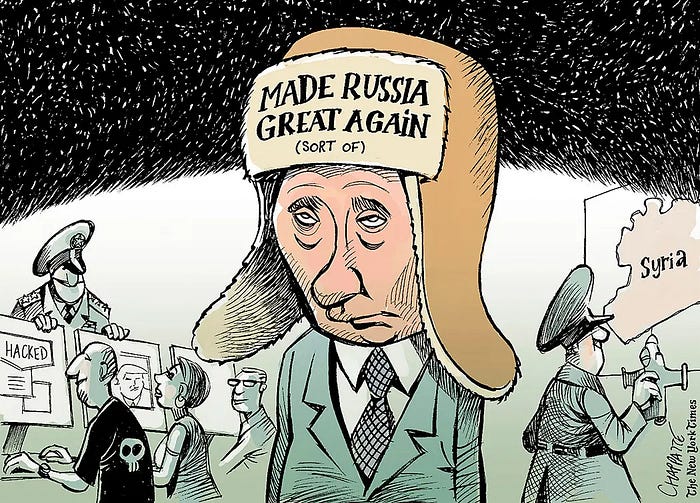
It all started many years ago…
The Western populations have been force fed a steady diet of anti-Russian and anti-Putin propaganda for decades, and all those propaganda chickens are now coming home to roost.
Americans, Britons, Canadians, Europeans have all been lied to so much and for so long that they are literally willing to believe ANYTHING about Russia and about its President.
This is a very dangerous development. It is already leading to some serious cognitive dissonance, and will, eventually, lead to psychic shock of a most devastating kind.
And the worst thing is: no one in charge even knows the truth. It is one thing to mislead the citizenry; it is another thing to mislead yourself and the decision makers.
In short, it is a very dangerous situation when leaders start to actually believe their own propaganda.
Vladimir Putin was a hero to the West — until he wasn’t
When Boris Yeltsin chose Vladimir Putin to succeed him, the West cheered. Putin was a devout anti-communist, and his narrow but decisive victory in the elections over his main challenger in the Communist Party was seen as historic, and one that cemented Russia’s West-leaning future.
In December 2001, Thomas Friedman wrote in The New York Times:
“Today, Russian foreign policy is about two things — geopolitics and geoeconomics — and there is a real competition between the two. If Russians believe they can be powerful on the basis of geoeconomics…the chances of their being real partners with the West will be much, much greater.
“So keep rootin’ for Putin…”
Putin was seen as a reformer, a “sober Yeltsin”, a “real partner” with the West, as Friedman put it.
George W. Bush was famously enamoured of Putin:
“I looked the man in the eye. I found him to be very straightforward and trustworthy. We had a very good dialogue. I was able to get a sense of his soul; a man deeply committed to his country and the best interests of his country.”
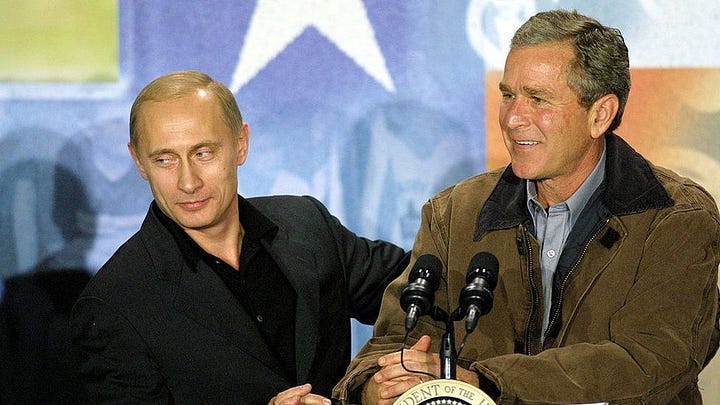
Even Barack Obama praised Putin, saying:
“I am aware of not only the extraordinary work that you’ve done on behalf of the Russian people” and “We think there’s an excellent opportunity to put U.S.-Russian relations on a much stronger footing”.
Obama thanked Putin publicly and profusely for the Russian leader’s help in Syria and the massive assistance Russia provided in sealing the Iran nuclear deal.
And Obama wasn’t the only one. Canadian pundit Thomas Walkom wrote that Putin’s help in Syria had made him friends all over. “Now world leaders are lining up to break bread with the autocratic Russian president”, he noted.

So what happened?
Hillary Clinton lost the 2016 Presidential Election. THAT’s what happened.
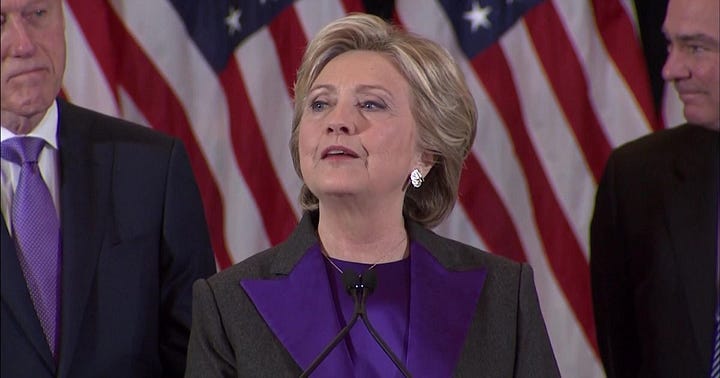
What’s in this article
This is a long form article, so I have broken it into 10 segments. You can click on the links below to jump to s particular section if you want.
How Russiagate ruined the world — explains how the current epidemic of Russophobia started.
Russia is now a “fascist empire” — how the West has come to perceive Russia as a modern day Nazi Germany and Putin as a modern-day Hitler.
The “dismissive” side of Russophobia — how, despite being a monstrous threat, Russia is portrayed as weak and technologically retarded, while Russians are incompetent savages.
Why Russophobia is an “irrational fear” — why the West’s hatred and fear of Russia is based on cognitive dissonance (believing two fundamentally contradictory precepts).
How Western propaganda leverages Russophobia — the way western leaders and media use Russophobic precepts to frame and support their narratives.
The truth about the “Special Military Operation” — what has actually happened over the past year and how it differs from what was told to western audiences.
The Spring Counteroffensive: Ukraine’s greatest lie — how winning the Information War has become more important than winning on the battlefield.
The Russian Army is a SERIOUS Army — something that used to go without saying, but now needs to be said.
Here’s what’s REALLY happening — a realistic recap of the state of play.
The Information War is what counts — some examples of how Ukraine and the West are punking us every day.
1. How “Russiagate” ruined the world
It started in 2016, when a horde of highly embarrassing and incriminating emails from the Hillary Clinton campaign and the Democratic National Committee (DNC) were leaked to Wikileaks and then published.
The emails showed corruption at the highest ranks of the DNC and proved, beyond doubt, that the Democratic Party, at Hillary Clinton’s behest, stole the Presidential nomination from Bernie Sanders.
The Democrats and Clinton had to come up with an alternative story — and fast.
Enter a Ukrainian cybersecurity firm called Crowdstrike, which was working under contract with the DNC — despite having a checkered history of falsifying findings. The company’s founder and CTO, Dmitri Alperovitch, was (and is) a rabid anti-Putin political operative who also serves as a Senior Fellow at the Atlantic Council, NATO’s official think tank.
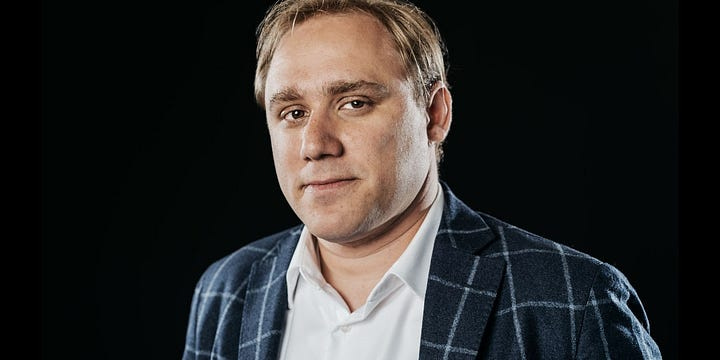
They were happy to claim that they had evidence that “Russian hackers” had stolen the emails.
That accusation launched a huge wave of Russophobia, fuelled by the Clinton campaign, and turbocharged by their allegations that “Vladimir Putin was helping Donald Trump”, Clinton’s opponent.
In 2017, the CEO of Crowdstrike admitted in sworn Congressional testimony that they had never had ANY proof of a hack — but by then it was too late.
The story became the accepted narrative. Even today, Wikpipedia still links Trump and Putin to the infamous (but non-existent) “hack”.
Back to 2016: Undaunted by truth, Clinton and her campaign steamed ahead, planting additional stories about Trump and Putin “collusion”, making the most outrageous and salacious accusations, asserting that Putin had Trump in his pocket, and so on.
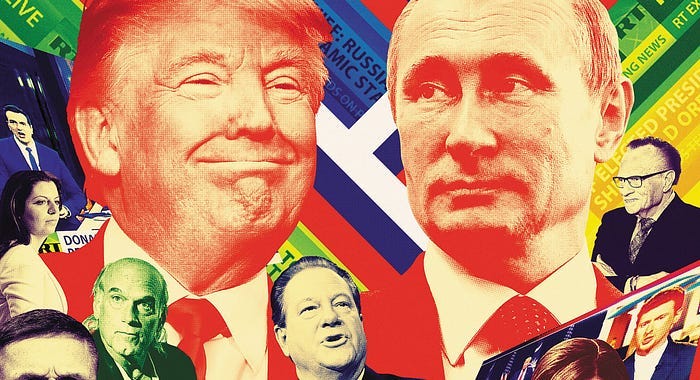
And when Trump won the election in November, the Clinton camp shifted into overdrive: “the Russians hacked our elections!” they claimed. Most Democrats still believe this to be true, even though the claim was proven to be bogus, and the underlying “evidence” was 100% falsified by a consultant on the Clinton payroll.
The two people the Western Elites love to hate
The sensational, often hysterical assertions of Russian interference and Trump collusion were subsequently disproved by the Mueller Investigation and later by the Durham Investigation, but back then, American people believed the lies:
The Democrats in Washington wasted no time in beating the drums for war, claiming that the “Russian interference” in the election amounted to “a modern day Pearl Harbor” and demanding ACTION.
Russophobia continued to rampage across all sectors of the American consciousness, as Putin became inextricably linked to Trump, and those who hated one were told they must hate the other, because they were “colluding”.
The Trump-Putin propaganda rapidly spread to Europe — even to places like Lithuania:
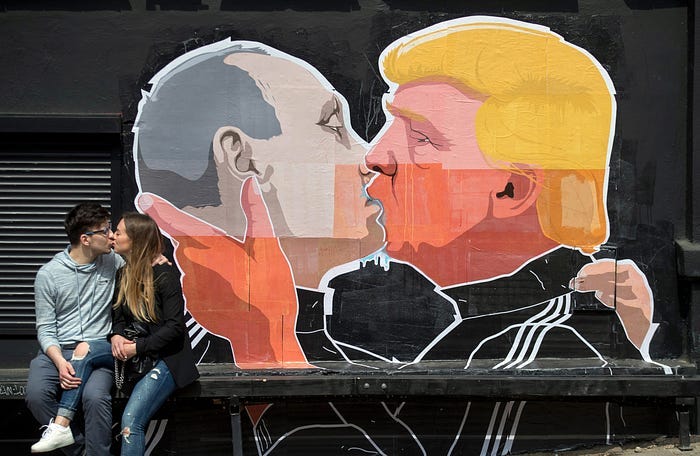
The Trump-Putin collusion association — always 100% concocted and baseless — had wide ranging political repercussions . The hoax actually changed US international policy (for the worse).
No one realised then the world-changing consequences of the Russiagate conspiracy theory, and its offshoot, “Ukrainegate” (the fake “scandal” behind Trump’s impeachment), but the accusations of fascism levelled against Trump by the Western elites was now being transferred with renewed vigour to Vladimir Putin.
2. Russia is now a “fascist empire”
Gone are the days when Hillary Clinton talked about a “Great Reset” in US-Russian relations. Her doubling down on “Russian collusion” meant that there was no going back — Russia was now “a clear and present danger” and had to be demonised at every turn.
Putin — according to the West — is an expansionist imperial megalomaniac, a narcissistic dictator who fancies himself to be a modern day Peter the Great (and/or Stalin); a ruthless imperialist who is hell-bent on reconstituting the Russian Empire (and/or the Soviet Union).
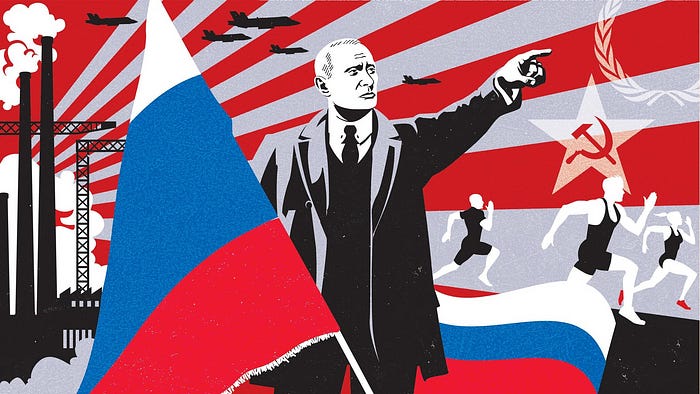
Forget all those stories you heard about Russia losing 27 million people in order to defeat fascism.
Russia, under Putin, is now a “fascist” state.
Three months after Putin launched his Special Military Operation in Ukraine, Timothy Snyder wrote in The New York Times that Russia meets most of the criteria for being a fascist state:
It has a cult around a single leader, Vladimir Putin. It has a cult of the dead, organized around World War II. It has a myth of a past golden age of imperial greatness, to be restored by a war of healing violence — the murderous war on Ukraine.
Snyder, a professor at Yale, is one of the West’s most prolific anti-Russian propagandists. His depiction of modern-day Russia as a fascist totalitarian state has spread, however, to all corners of Western academia — and media.
“Putin is Hitler”
The “Fascist Russia” meme has even spread to Western political leadership, and with it, the inevitable comparison of Putin to Hitler.
In fact, social media is inundated with references to “Putler”. The term even has its own Wikipedia page.
Outlets like CNN and The Spectator say that Putin is following Hitler’s playbook, and fake media memes are even circulating:
Even Western political leaders are jumping on the “Putin-Hitler” bandwagon. Leo Varadkar, the Taoiseach of Ireland, is the country’s Prime Minister and Head of Government. Following the launch of Russia’s SMO,he declared that Putin was literally a modern-day Hitler:
“We knew that Putin was a bad man, we’ve known that for a long time now, but we didn’t think that he would be the Hitler of the 21st century, and I think he’s putting himself into that space.”
This statement is actually shocking when you stop to think that Ireland is officially a neutral country and is not even a member of NATO.
Academicians and think tanks are constantly churning out the most sensational — if not hysterical — polemics portraying Putin as Hitler.
And of course, they are all quick to point out that UKRAINE IS JUST THE BEGINNING.
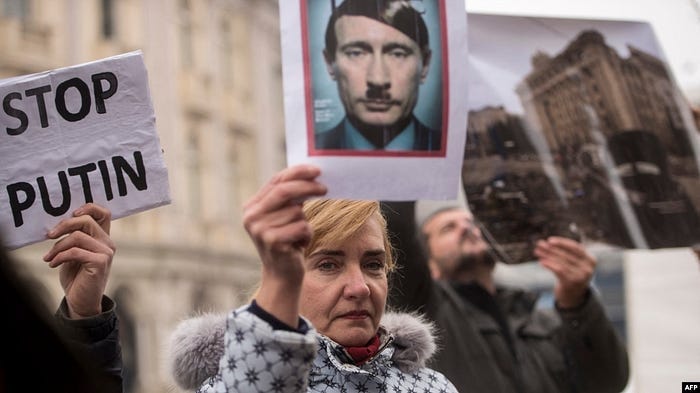
For example: Jonathan Katz, a German Marshall Fund senior fellow and director of Democracy Initiatives, told Voice of America that Putin “is this century’s equivalent to Hitler, and the threat he poses to Europe, U.S. and global security extends far beyond the current conflict in Ukraine.”
“Like Hitler, Putin has amassed unquestionable power in Russia, wiped out political opposition with little to no check on his regime and its use of military force or other hybrid tools to brutally carve out and illegally conquer territory in surrounding nations”, Katz added.
Putin, Katz tells VOA, “disturbingly mirrors traits of Hitler — cold and calculated, showing no remorse or interests in the sanctity of human life.”
No “appeasement”
Another corollary to this “Hitler is Putin” meme is the idea that Ukraine is like the Sudetenland in 1938, and that Poland and other countries will soon fall to Putin if he is not stopped.
Any attempt to negotiate with Russia will be instantly condemned as “appeasement” and a catastrophic mistake similar to that of Chamberlain at Munich.
This narrative is older than you might think. It even applied to the Minsk Accords in 2014, when Germany and France were negotiating a peace in the Donbas.
In a 2014 article entitled, “Is Vladimir Putin Another Adolf Hitler?” a Forbes contributor wrote:
What’s to stop Putin? The West is led by the modern equivalents of Chamberlain: President François Hollande of France is a political nonentity repudiated by his own compatriots; Prime Minister David Cameron of Britain and Chancellor Angela Merkel of Germany have both ruled out the use of force to stop Putin from annexing Ukraine; and worst of all, President Barack Obama — the one man who has the power to stop Putin in his tracks — does nothing. He makes Neville Chamberlain seem like a bellicose activist.
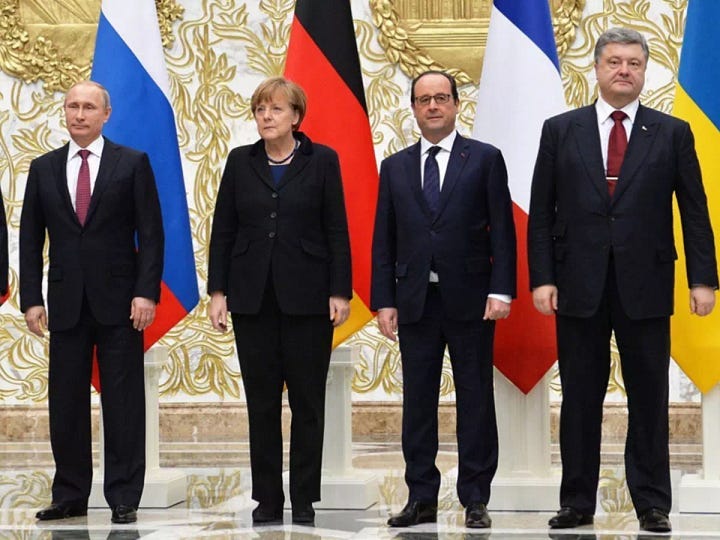
“Worse than Stalin”
A corollary to the “Putin is Hitler” meme is the “Putin is worse than Stalin” meme. This narrative maintains that Russia is now a totalitarian state, with a cult of personality — more like North Korea than the old USSR, where the greatest crime is to do or say anything that can be interpreted as opposing the “Dear Leader”. It is in many ways WORSE than it was under the USSR.
This implies, of course that the Russians themselves do not REALLY support Putin or the Special Military Operation in Ukraine.
3. The “dismissive” side of Russophobia
The US and the West have for years been propagandised to think of Russians as evil incarnate, nefarious actors hell bent on destroying Western civilisation.
But there is another side of the West’s view of Russia — a more “dismissive” or “disparaging” side. These propaganda narratives portray Russia as small, weak, backward, mired in a totalitarian past, “old fashioned” (e.g., anti-LGBTQ), technologically retarded, and generally incompetent.
Obama belittles Russia and Putin
During the 2012 Presidential Election campaign, Barack Obama criticised his opponent, Mitt Romney, for naming Russia as the US’s biggest international threat.
“The 1980s are now calling to ask for their foreign policy back because the Cold War’s been over for 20 years,” Obama said.
Indeed, Obama’s view of a weak Russia was echoed even by Romney’s own team:
Many experts, including some close to [Romney’s] campaign, see a declining power that the United States will need to help manage global challenges.
After the 2014 annexation of Crimea, Obama doubled down on his idea that Russia is only a “weak” regional power, not a superpower:
“Russia is a regional power that is threatening some of its immediate neighbours, not out of strength but out of weakness,” Obama said.
As for Putin, Obama was equally dismissive. He described the Russian leader as a small-time, gangster-like Chicago pol:
“Putin did, in fact, remind me of the sorts of men who had once run the Chicago machine or Tammany Hall [a New York City political organisation] — tough, street-smart, unsentimental characters who knew what they knew, who never moved outside their narrow experiences, and who viewed patronage, bribery, shakedowns, fraud, and occasional violence as legitimate tools of the trade.”
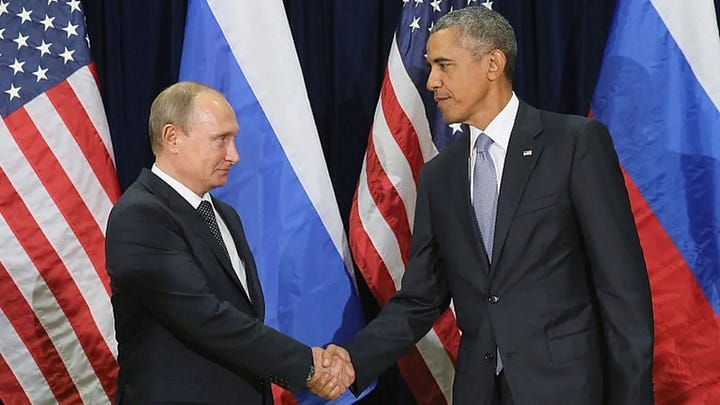
“Russia doesn’t make anything”
Another anti-Russian narrative was the idea that Russia is economically backwards, that their nation relies solely on natural resources and not technology.
Barack Obama famously dismissed Russia as insignificant in an interview with Reuters in 2014:
Obama downplayed Moscow’s role in the world, dismissing President Vladimir Putin as a leader causing short-term trouble for political gain that will hurt Russia in the long term.
“I do think it’s important to keep perspective. Russia doesn’t make anything,” Obama said in the interview.
“Immigrants aren’t rushing to Moscow in search of opportunity. The life expectancy of the Russian male is around 60 years old. The population is shrinking,” he said.
Russia only makes tractors … and SPACECRAFT
While these Americans were downplaying Russia’s technological capability, the US had to go begging Russia for a ride on Soyuz every time they wanted to put an astronaut into space.
And that wasn’t the only way that the US space program was dependent on Russia.
The Atlas V rocket — built by Lockheed Martin and used to launch American military satellites and civilian payloads — runs on a Russian-built engine.
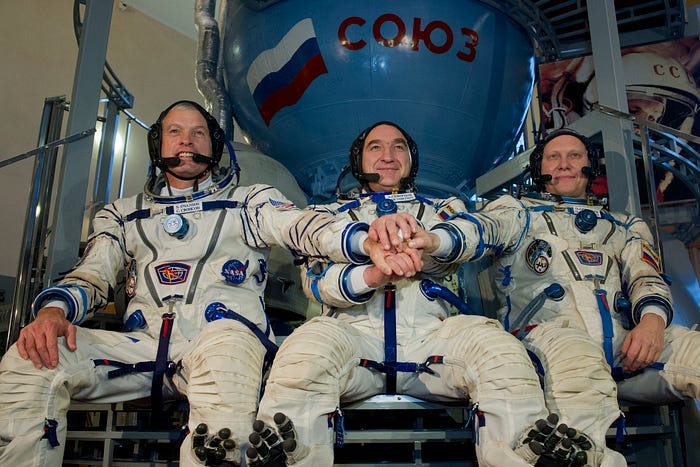
“A gas station masquerading as a country”
US Senator John McCain, who was always one of the most rabid, slavering, warmongering cheerleaders for Ukraine and detractors of Russia, once went to the Senate floor with his good friend and fellow pro-Ukraine maniac, Lindsay Graham to denounce and denigrate Russia and Putin.
“I have no illusions or worry about the long-term future of Russia. Russia is now a gas station masquerading as a country,” McCain said.
“They are an oil and gas company masquerading as a country,” Graham agreed.
McCain’s “Russia is a gas station” meme became an instant hit. People started to repeat it. It went so viral as to reach the loftiest heights of US economic thought.
Indeed, in February 2022, on the eve of Russia’s entering Ukraine, Jason Furman, a Harvard economist who chaired the Council of Economic Advisers in the Obama administration, reiterated McCain’s “zinger”:
“Russia is incredibly unimportant in the global economy except for oil and gas,” he said. “It’s basically a big gas station.”
That same month, Chris Isidore, Senior Writer for CNN Business, also stressed the insignificant nature of Russia “except for oil and gas”.
Eight years after McCain first coined the “gas station” metaphor, his words surfaced again on the other side of the Atlantic.
On August 19, 2023, EU foreign policy chief Josep Borrell, in an interview with the Spanish newspaper El País, called Russia an “economic dwarf.”
“Russia is an economic dwarf, like a gas station, the owner of which owns an atomic bomb,” Borrell said.
It is obvious that the collective West has now internalised the ridiculous McCain sound bite, first uttered as a catchy quip almost a decade ago — to the point where that would-be aphorism now comprises the entire European Union foreign policy and diplomatic position vis-a-vis one of the world’s great powers.
Indeed, the fact that Borrell made his idiotic statement just a few days after Russia launched a new lunar probe mission shows just how intellectually destitute the western leadership is.
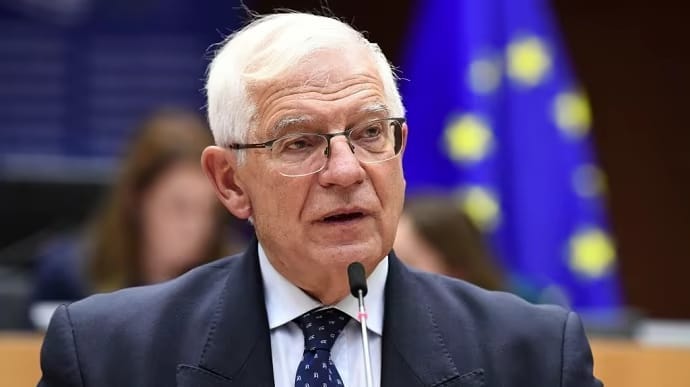
4. Why Russophobia is an “irrational fear”
What makes Russophobia a true “phobia” in the clinical sense is that Russophobia, as it exists in the West, is a completely irrational sense of fear and hatred regarding Russia.
Specifically, Russophobia is irrational because it rests on two fundamental, but also fundamentally incompatible, precepts:
First, Russia is a globe-straddling superpower that is poised to roll across Europe like the Mongol hordes, sweeping all armies and peoples before it, and Putin is a modern day Hitler who is somehow also a modern day Peter the Great and/or Stalin and hell-bent on reconstituting the Russian Empire and/or the Soviet Union.
Second, Russia is a socioeconomically retarded backwater, a third world country with no industrial or technological capacity, a country running out of everything, with incompetent leadership and cowardly soldiers who run away at the first sign of a fight, and Russia is nothing but “a gas station masquerading as a country”, as John McCain said, and Putin is a petty thug, a weak leader who can only make life difficult for his immediate neighbors, as Barack Obama said.
These two diametrically opposed views of Russia are necessary for the warmongering Neocons in the West to build and sustain a conflict designed to “strategically defeat” Russia and overthrow Vladimir Putin.
You see, the first precept is necessary to galvanise public support for the war. The people need to believe that Russia is a new Nazi Germany and poses a threat not just to Ukraine but to all of Europe and indeed, the entire world.
As US Representative Adam Schiff has said: “The United States aids Ukraine and her people so that they can fight Russia over there, and we don’t have to fight Russia here”.
The “Russia is a global threat” argument was necessary to ensure that the anti-Russian sanctions regime would be followed by everyone in the West; that every Western ally would supply weapons and aid to Ukraine; that blank checks for Ukraine would be issued by every Western government.
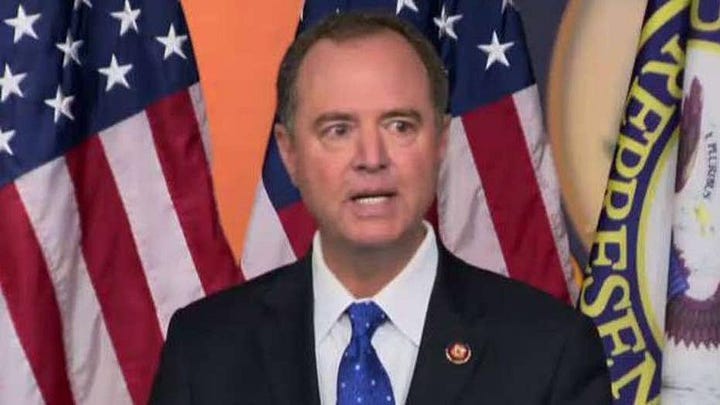
The second precept, that of Russia being a small, weak power that cannot sustain or even manage a prolonged military conflict, was also necessary to ensure that the flow of money and arms to Ukraine would never end; that the people of the West could be easily propagandised into believing that victory was always just within reach, that Ukraine was winning, that the horrible, evil, brutal Russians were being vanquished by the brave Ukrainians. And that Putin was about to be overthrown.Portraying Russia as being both an evil threat and an incompetent third world backwater meant that Western populations could literally be convinced of ANYTHING.
No Russian villainy was too cartoonish, no Russian atrocity beyond the pale; no Russian defeat too improbable — while no Ukrainian virtue was too romantic, no Ukrainian anecdote too heroic; no Ukrainian victory too overwhelming to be believed.
5. How Western propaganda leverages Russophobia
Western leaders and media outlets spent decades stoking Russophobia in their populations. When Putin launched his Special Military Operation in February 2022, they pounced — putting that carefully built up store of racism and anti-Russian bias to work.
Framing the SMO
Immediately, the verdict was in. There was no place on Western media where the Russian incursion into Ukraine was not universally — and repeatedly — portrayed as being “unprovoked”.
As the media analysis organisation FAIR noted at the time:
It’s a word that has been echoed repeatedly across the media ecosystem. “Putin’s forces entered Ukraine’s second-largest city on the fourth day of the unprovoked invasion,” Axios (2/27/22) reported; “Russia’s unprovoked invasion of Ukraine entered its second week Friday,” said CNBC (3/4/22). Vox (3/1/22) wrote of “Putin’s decision to launch an unprovoked and unnecessary war with the second-largest country in Europe.”
For the unwitting Western audience, it appeared as if Putin woke up one morning and decided to invade Ukraine. The reality, of course was far different.
Indeed, even a cursory review of the lead up to the Ukraine conflict shows that the military action was literally the last resort open to Putin, and Russia had been struggling for DECADE to avoid it.
The Sanctions Folly
One of the first things the West did to “punish” Russia for Ukraine was to double down on the sanctions regime they had imposed on Russia following the annexation of Crimea.
Since 2014, the West has imposed 11 rounds of sanctions. The problem is, the sanctions have BACKFIRED.
First, the Ruble has not been “turned to rubble” as President Joe Biden promised. Instead, the Ruble became the strongest currency in the world, and certainly much stronger than before the sanctions went into effect.
Second, the Russian economy has rebounded and is now stronger than ever. Russia is selling just as much oil, gas and other resources as it ever did — to new customers like China, India, Malaysia, Indonesia and other Asian countries, as well as in Africa and Latin America and elsewhere.
What “the whole world” means for the West
Westerners keep hearing that “the entire world is united against Russia”. This is not true. Those who make such claims point to a UN resolution condemning the Russian incursion into Ukraine, in which 141 countries “voted against Russia”.
Yes, but that does not mean that those countries will not continue to trade with Russia, or conduct business with Russia.
The fact is, 85% of the world’s population has refused to impose sanctions on Russia.
Only 45 countries have agreed to impose sanctions on Russia - and most of those are NATO members.
So — contrary to what people like Joe Biden, Ursula von der Leyen and Olaf Scholz may say, Russia’s economy is NOT “in tatters”. It is doing very well.
In fact, the International Monetary Fund (IMF) predicts 0.7% GROWTH for the Russian economy in 2023.
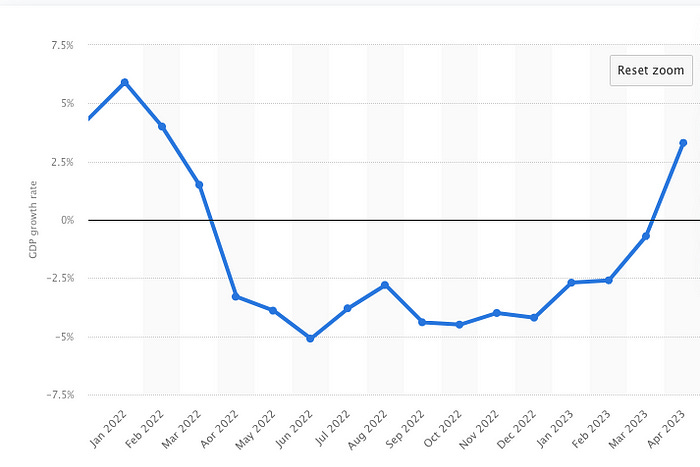
In fact …

Russia’s famous “dishwasher chips”
Once the conflict in Ukraine kicked off, the Western elites rushed to push the idea of Russian technological inferiority — an inferiority that was only being made worse by Western imposed sanctions.
An example of this phenomenon is the State of the Union speech given by European Commission President Ursula von der Leyen in September 2022. In it, she portrayed Russia as an economic basket case and the Ukrainians as “European heroes”:
“Russia’s financial sector is on life-support. We have cut off three quarters of Russia’s banking sector from international markets”, the EC chief said.
“The Russian military is taking chips from dishwashers and refrigerators to fix their military hardware, because they ran out of semiconductors. Russia’s industry is in tatters. It is the Kremlin that has put Russia’s economy on the path to oblivion”.
“Glory to a country of European heroes. Slava Ukraini!”
“This is the time for us to show resolve, not appeasement”, von der Leyen declared.
6. The truth about the “Special Military Operation”
As many know, the Russians are not referring to the conflict in Ukraine as an “invasion”, and it is actually illegal in Russia to refer to the Ukraine conflict as a “war” or an “invasion”.
There is a good reason for that.
Putin never planned to “conquer” Ukraine. He never intended to wage a war against Ukraine. He invaded with only 150,000 men, which is less than 10% of what he would need to actually invade and conquer a country the size of Ukraine. Many more would be needed.
When Hitler decided to conquer Poland, for example, he invaded with a Blitzkrieg force of 1.5 MILLION men. It is ludicrous to believe that Putin thought he only needed 1/10th of that to subjugate Ukraine — a country twice as big as Poland, and one which he knew to have been “militarised” by NATO since 2014, with billions in weapons, arms, supplies, and trained in the latest NATO combat techniques.
No — Putin did not want to “invade” or “go to war” against the Ukrainians, whom the Russian national anthem refers to as a “Fraternal People”.
The purpose of the Special Military Operation was ALWAYS just one thing: to force Ukraine to the negotiating table.
AND HE ALMOST SUCCEEDED.
The Peace Plan that almost was
Many westerners are completely unaware that Zelensky was prepared in March 2022 to strike a peace deal with Putin that would guarantee Ukrainian neutrality.

The Russian-Ukrainian peace talks started in late February, shortly after Russia had crossed the border into Ukraine. The two sides met in Istanbul March 29 to enter what The New York Times said was a “new phase” of negotiations:
After more than a month of talks — first in person in Belarus, then in recent weeks by video link — the diplomacy between Ukraine and Russia running in parallel to their war entered a new phase on Tuesday. The fact that the negotiations had become more serious was reflected in the setting, the palace where Mr. Erdogan — who has maintained ties with both Moscow and Kyiv — often holds major government events when in Istanbul.
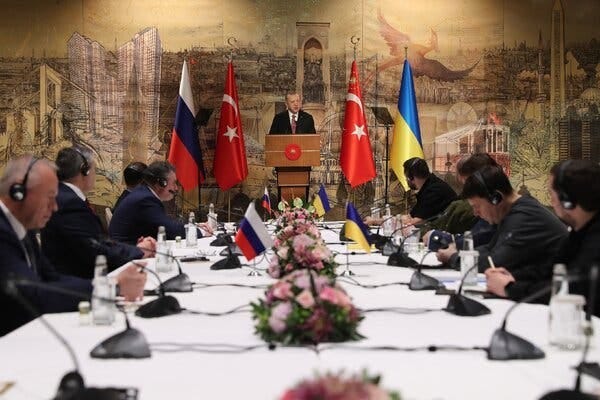
In the Istanbul meeting, the two sides agreed a draft comprehensive agreement.
Russia topped off the meeting by offering to withdraw their forces from Kyiv and other places as an immediate “good will gesture”.
Ukraine proposed adopting neutral status and a 15-year consultation period on the future of Russian-occupied Crimea as long as a complete ceasefire with Russian forces is agreed, negotiators said at the conclusion of peace talks in Istanbul on Tuesday.
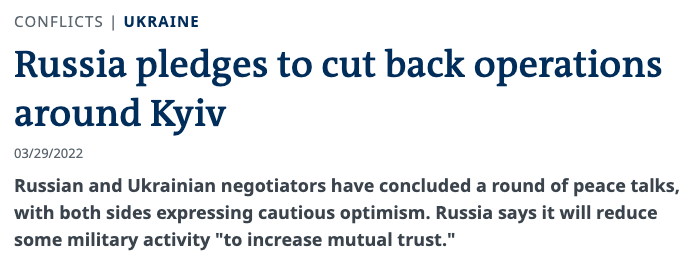
Johnson scuttles the peace deal
Yes, it seemed for a few precious days that “peace would break out” in Ukraine.
Then Boris Johnson arrived.
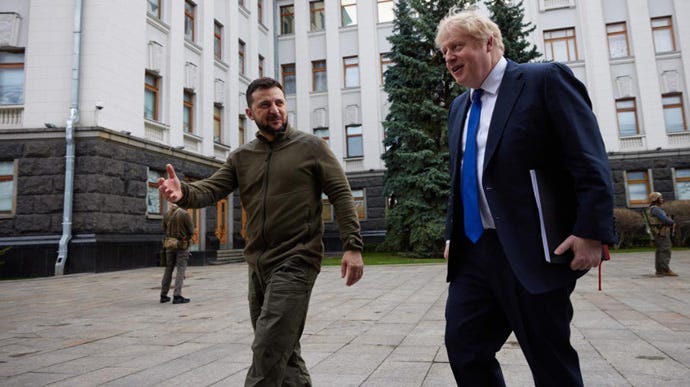
Ukrayinska Pravda (Ukrainian Pravda), reported that Johnson arrived suddenly, “without warning” on April 9, swooping down like some perverse deus ex machina to kill the infant peace deal in its crib.
A close associate of Zelensky described Johnson’s meeting with the Ukrainian President as follows:
“Johnson brought two simple messages to Kyiv: Putin is a war criminal, he should be suppressed, not negotiated with. And secondly, if you are ready to sign any agreements on guarantees with him, then we are not”.
The UP article continues:
Johnson’s position was that the collective West, which back in February had suggested Zelenskyy should surrender and flee, now felt that Putin was not really as powerful as they had previously imagined.
After Johnson’s intervention, according to the article, there was no chance of peace talks progressing.
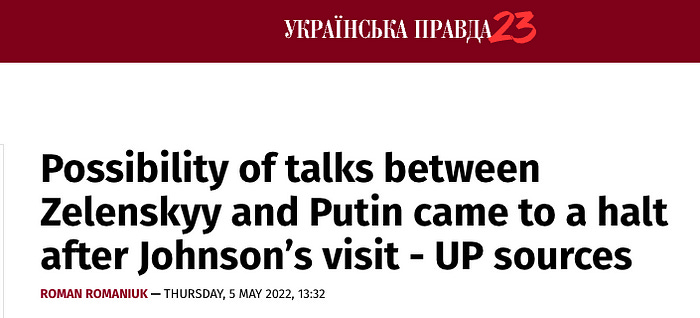
Russia’s “retreat” from Kiev
But what about Putin’s promise to withdraw his forces from Kiev and elsewhere?
Western news media, such as Reuters, reported on April 6 — three days BEFORE Johnson’s visit — that Putin had made good on his promise and completed his withdrawal from Kyiv.

Ukraine and the West had tricked Putin into withdrawing. It was Minsk all over again.
The Western propaganda machine kicked into overdrive as soon as the SMO started: Ukraine was winning, Russia was losing. The TV was bombarded with scary photos of a long Russian column heading for the Ukrainian capital, but there were plucky Ukrainian defenders there to hold the line.
And of course when Putin withdrew as promised, the story became that the Ukrainians had beaten back the Russian assault and forced the Russians to head home, away from their beloved city.
Even Boris Johnson, who knew the truth, took time out during his visit to Kiev to publicly praise the “invincible heroism and courage” of the Ukrainians:
“Ukraine has defied the odds and pushed back Russian forces from the gates of Kyiv, achieving the greatest feat of arms of the 21st century”, he gushed.
Except that’s not what happened.
We now know that Russia withdrew their troops from Kiev as a “good will” gesture and as part of the final negotiations of a draft Peace Treaty that Russia and Ukraine had agreed in Istanbul.
But a gracious Russian voluntary withdrawal from Kiev did not fit the Western narrative of “plucky Ukrainians” versus “incompetent Russians”.
No — the headlines in the Financial Times were more in line with the propaganda line:
And from The New Yorker:
The Ukrainians were built up to be almost mythic in their bravery and their ability to vanquish the far larger foe. “The Russian military, which was superior in numbers and firepower, was widely predicted to prevail”, explains The New Yorker article.
Citing a “litany of mistakes” by the Russians, The Guardian gave a breathless account of the battle:
“Russia at one point had an astonishing 12 to 1 advantage in troop numbers north of Kyiv…But the Russians…could not make weight of numbers count…The attackers had failed because Putin and the Kremlin had comprehensively misjudged the situation, and their opponents…The way the Russians designed their campaign and the key planning assumptions they made fundamentally undermined their chances of success on the battlefield”.
So — there you have it: brave Ukrainians drive out the incapable Russians thanks to their “invincible heroism and courage”.
Ukraine’s Fall Offensive
The western propaganda machine cranked into high gear again in the fall of 2022, when Ukraine again launched “blitzkriegs” against Kharkiv and Kherson.
The western media had to use the word blitzkrieg because the Ukrainians were retaking ground and villages so quickly.

In Kharkiv, the BBC crowed about how the Russians were outnumbered 8 to 1, and how the Ukrainians had taken over 20 villages in just 24 hours. It was obvious that the Ukrainians were just waltzing into the Kharkiv area, which had practically no opposing forces in it.
The western press once more hailed the Ukrainians’ invincible heroism.
What were the Russians doing?

The answer is simple: once it became apparent that the “collective West” would never allow Zelensky to negotiate, but rather was prepared to supply Ukraine with ever more weapons, the Russians decided to make a strategic withdrawal and hole up for the winter while they prepared for a wider and more serious conflict.
They withdrew from Kharkiv and sent the troops down south, to build fortifications around central Donetsk and to consolidate with the troops they were removing from Kherson.
The withdrawal from Kherson was more dicey — the Russians had to move all their troops and supplies from the western bank of the Dnieper to the eastern bank, because they believed the Ukrainians were getting ready to flood the Dnieper river, and they wanted to have their troops in a place from which they could safely evacuate.
Konrad Muzyka, a Polish military analyst, told Reuters that it was logical for Russia to pull back for the winter:
“If the Russians withdraw now, not only will they have more forces to prepare the defences of the eastern bank of the river, but they will also have some forces to actually move around and deploy to other areas (of Ukraine),” he said.
And yet, the Ukrainians, like the rooster taking credit for the sunrise, claimed that they had won a “major victory” and defeated the Russians in the”Battle for Kherson”:

Indeed, The New York Times expressed the Western sentiment at the time quite succinctly:
“In the wake of a stunning counteroffensive in which Ukrainian forces reclaimed thousands of square miles of territory, Russia is uneasy,” the article asserts.
But in reality, Ukraine’s “stunning” fall counteroffensive consisted mostly of Ukrainian forces simply moving into areas that the Russians had already vacated.
These fake Ukrainian “blitzkriegs” elicited high praise and celebrations in the West, but they also served to reinforce that second point of the Russophobic mantra: Russia was weak and incompetent.
The miracle of Russian artillery supply
Western officials started predicting that Russia was running out of ammunition as early as March 2022.
Moreover, in keeping with that second tenet of Russophobic propaganda, the Western media was constantly saying that not only was Russia running out of ammo, the munitions and weapons they had left were “decades old”, or “Soviet era”.
Every month the message was the same:










In September they said that Russia had turned to North Korea for replenishment.
In November Lloyd Austin, America’s defence secretary, spoke of “significant shortages”.
On December 14, 2022, Admiral Sir Tony Radakin, Britain’s chief of defence staff, declared: “So let me tell Putin tonight what his own generals and ministers are probably too afraid to say : Russia faces a critical shortage of artillery munitions.”
Ten days earlier Avril Haines, America’s top intelligence official, had offered a similar assessment.
One year later — they are STILL doing it!
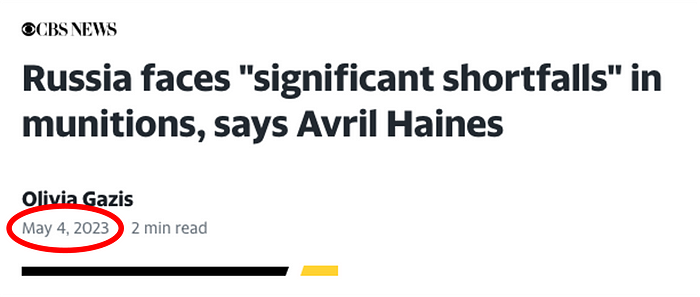
The truth about Russian supplies:
Russia has completely restructured its economy. Once it became clear that Ukraine and the West did not want to negotiate, that they in fact WANTED WAR, Putin realised that he was at war not with Ukraine, but with NATO, and that this war was one of existential nature for Russia.
Russians reacted as any nation would when its very existence is threatened.
On the battlefield, the Russians withdrew and dug in, husbanding their resources. Meanwhile, on the home front, Putin ramped up military production by 270%, with factories running 24/7 churning out tanks, artillery, aircraft, missiles, drones and other materiel.

The fact is, Russia will NEVER run out of weapons or ammunition. They have transformed their economy into a war machine, pumping out weapons at a huge scale, while the West dithers, trying to find the funds to increase their production, wondering whether it is worth it.

7. The Spring Counteroffensive - Ukraine’s greatest lie
Of all the massive, sophisticated propaganda campaigns launched by Ukraine and the West in the ongoing information war, the greatest may be that of the Ukrainian “Spring Counteroffensive”.
What made this critical military operation so unique is that it was ADVERTISED.
First, the attack was foreshadowed with the release of a slick, Hollywood style video showcasing all the shiny new weapons systems they were getting from NATO — their benefactors, who were no doubt also the target audience of the clip.
Then, they released another video — a trailer, whose purpose can be nothing more than to “tease” the Counteroffensive.
What army advertises their counteroffensive?
The answer is: an army that is more interested in fighting the “Information War” than the actual one.
What was supposed to happen
In March and April, talk of the impending counteroffensive dominated much of Western media. Most articles said that the attack would take place in the Zaporizhzhia area.
The idea was to cut through the Russian lines and reach the ea of Azov, thereby cutting off Crimea and breaking the “land bridge” that Russia had created last year.
They also said it would be fast and quick.
“Like with [Ukraine’s] fast and smart push around Izyum and Kharkiv in the late summer last year, we may only learn of success once it has been conclusively achieved”, said CNN.
It was clear: the Western media were looking forward to lightning fast “blitzkrieg” advances such as the ones Ukraine reported in their 2022 “counteroffensive” around Kyiv, Kharkiv and Kherson.
They were believing their own hype — they didn’t realise that those “counteroffensives” were conducted mostly against areas abandoned by the Russians.
This time, the Ukrainians were going to face actual Russian forces, in actual defensive positions.
What actually did happen
The counteroffensive, when it started, was not announced. It was not until reports of firefights started filtering through Russian media that the West slowly became aware that the campaign was underway.
And it wasn’t going well.
The attack did take place in the Zaporizhzhia area, as predicted. But the “fast and smart push” never materialised.
By now, most of us have seen the footage and the videos of the massive destruction of Ukrainian armoured columns, replete with dozens of burned out Leopard 2 tanks, Bradley fighting vehicles, and other western vehicles.
Moreover, the vaunted “NATO-trained” troops that led the counteroffensive had been decimated. In all, around 30% of the NATO equipped and trained attack forces had been wiped out in just the first week.
It was an unmitigated disaster.
What was reported to have happened
Amid the destruction, the spinmeisters in the Ukrainian government sprung into action. The counteroffensive was never supposed to be like last year, they said. It was always supposed to be long, drawn out “slog” rather than a lightning fast strike like before.
The attacks that are currently underway, which have seen the Ukrainian forces destroyed and repelled all along the contact line, are not actually “breaching assaults” intended to break through the Russian lines, they say. Rather, these are “probing attacks” and “reconnaissance in force” attacks.
Right — so that is where you commit your best troops and your most precious armour? To quasi-suicidal “probing attacks”?
On July 5, one month into the operation, Zelensky was ready with excuses.
President Volodymyr Zelensky of Ukraine said he had warned the United States and other Western nations that the counteroffensive would go slowly the longer it took allies to deliver the promised weapons and ammunition needed for the mission.
US General Mark Milley backed him up:
“It’s going to be very long, and it’s going to be very, very bloody, and no one should have any illusions about any of that,” General Milley said. “Ukrainian soldiers are assaulting through minefields and in the trenches, and this is literally a fight for their life. So, yes, sure, it goes a little slow, but that is part of the nature of war.”
The Ukrainians and Americans maintain that they have yet to commit the bulk of their forces, and are holding the special, NATO-trained troops and NATO-supplied equipment in reserve until a breaching spot in the Russian lines is found.
So what are all those things smashed up and burning on the steppes of Zaporizhzhia? How stupid do they think we are?
Or have they become so idiotic that they believe their own propaganda?
Bakhmut — a case in point
Ukraine has been assuring the West that they are making “tactically significant” advances around Bakhmut. But where? Don’t ask.
Right now, things around Bakhmut are in a frustrating position where reports of “good news!” are pouring in, but details on locations are still sketchy. It’s clear that Ukraine has made gains both north and south of the city, and the word “huge” keeps coming up. But I’m unable to collect the geo-confirmed information necessary to accurately map the changes of control.
Not a surprise.
On July 7, The Irish Times ran this story:
“The defence forces continue to hold the initiative there, putting pressure on the enemy, conducting assault operations and advancing on the northern and southern flanks,” Ukrainian military spokesman Serhii Cherevatyi said of the situation around Bakhmut.
“Over the past day, they have advanced more than a kilometre,” he said.
Yet, a reporter for the Italian news outlet Corriere della Sera, embedded with the Ukrainian 10th Mechanised Brigade, stationed on the northern flank of Bakhmut, reported ALSO on July 7 that the battalion commander told him that…
…his troops “had not advanced a single meter since June”.
Moreover, they had yet to receive any of the shiny new NATO weapons delivered to Kiev (again, not a surprise). They were forced to use Soviet-era equipment including an Italian mortar from 1963.
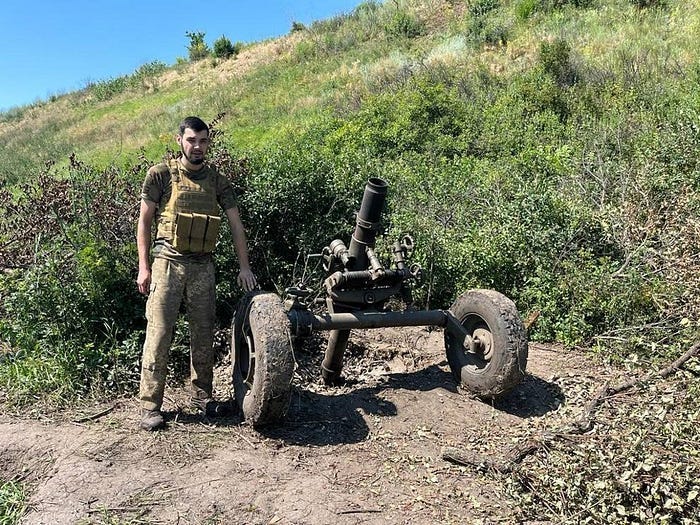
Obviously, we must rely on intrepid “non-anglo” journalists like this one in order to get the truth. I suppose the Ukrainian and Western censors don’t mind if the truth leaks out — as long as it’s not in English.
8. The Russian Army is a SERIOUS Army
Western leaders and western media elites are constantly pushing the line that the Russian Army is full of poorly-trained, demoralised conscripts, led by incompetent officers, who are sacrificed in “mass wave” suicide charges as “cannon fodder”.

Nothing could be further from the truth.
Russian troops are highly trained
The Russian troops are most definitely NOT “untrained”. The 300,000 men mobilised last fall have been going through extensive training since then. The strategic withdrawal of October-November 2022 allowed the Russians to consolidate their positions, dig in and hold while they trained up their army.
This is in stark contrast with the Ukrainian forces, which are going through a 3–week training course before being sent to the front.
Russian morale is sky high
In the first 24 hours following Putin’s announcement of the mobilisation, 10,000 people volunteered to join the armed services. Even today, 1400 people each day volunteer for the Russian Army.
Meanwhile, Ukraine is having to deploy “press gangs” to round up men for the front.
Russia is not taking heavy casualties
While the Russians may have suffered heavy losses in the initial stage of the SMO, they are not now. Ukrainian propaganda has asserted that the Russian/Ukrainian death toll is 10 to 1. THIS IS FALSE.
In reality, the ratio is reversed: there are 10 dead Ukrainians for every dead Russian.
Even western media outlets like The Guardian have admitted that Ukraine has been losing 20,000 men per month.
Russia is also outgunning Ukraine 10–1
Factually speaking, everyone agrees that the Ukraine conflict is an “artillery-driven war of attrition”, and even Ukrainian authorities admit that Russia enjoys a 10–1 advantage in artillery guns and shells fired each day (60,000 Russian shells to 6,500 Ukrainian ones).
The massive 10/1 advantage in artillery is what leads to the 10/1 casualty ratio in favour of the Russians.
This should not be a surprise. Putin has always sought to minimise casualties as much as possible, so as to maintain public support for the Special Military Operation, which remains strong at 75%.
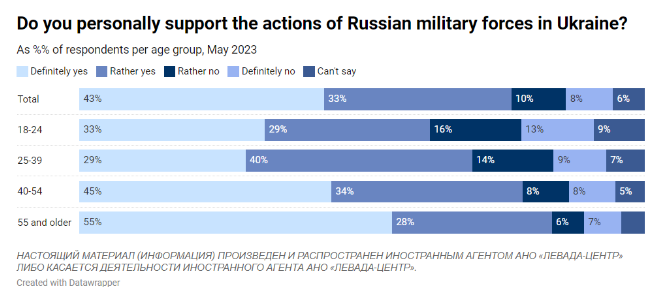
Meanwhile, Ukrainians are dying by the thousands — and have been doing so for over a year.

The casualties are mounting up so much that Ukrainian towns and cities are running out of space in their cemeteries.

9. Here’s what’s REALLY happening
In almost every aspect, what western leaders are saying, and what western media is reporting, is the complete opposite of the truth.
Russia
The Russian economy is not “in tatters” — it is as strong as it has ever been — if not stronger, with the world’s strongest currency and a positive growth forecast.
Russian technology is not backward — Russia has some of the most advanced weaponry in the world, including hypersonic cruise missiles which literally cannot be shot down (something the West does not have).
Russia is not running out of ammo or weapons — the Russian military industrial complex has increased their output by 270% since 2022. Their factories are working 24/7 — Russia is on a war economy.
Russians are not demoralised — currently 1400 people each day are signing up to fight in the SMO. Morale is extremely high.
The Russians are NOT losing men on a grand scale — the Russians are secure behind their fortifications and, while they are are losing men, they are doing so at the 1/10th the rate that Ukraine is.
Ukraine
The “Battle of Kyiv” was not a case of Ukrainian heroism — simply a case of the Russians executing a planned withdrawal that Putin had promised as part of a proposed peace deal in Istanbul.
The Fall Offensive was a fairy-tale — in Kharkiv and Kherson, the Ukrainian forces simply moved into territory that had been vacated by Russia.
The current Counteroffensive is failing — after 5 weeks, the Ukrainians have yet to even breach the first of the three lines of Russian defences, let alone take any meaningful town or other objective.
10. The Information War is what counts
The fact is, what is happening on the battleground is not important to the West. What matters is that they control the narrative:
Ukraine is winning and Russia is losing.
Ukrainians are virtuous and heroic, and Russians are sadistic and criminal.
Zelensky is a war hero, Putin is a war criminal.
Ukraine deserves to be in NATO, Russia deserves to be dissolved.
The “Ghost of Kyiv” shows how Ukraine will win the war
It was only a day after the beginning of Russia’s “Special Military Operation” that the Ukrainian armed forces began propagating a story about an almost superhuman hero, a Ukrainian Air Force MIG pilot known as the “Ghost of Kyiv”.
Ukrainian and western media started reporting that an unknown pilot of a MIG-29 fighter jet had downed six enemy planes in 30 hours. Memes and illustrations started circulating online with the hashtag #ghostofkyiv, collecting hundreds of millions of views.
Eventually, this hero was claimed to have shot down up to 40 Russian aircraft by himself.
The Ukrainian authorities eventually identified the pilot by name, and The Times of London wrote multiple articles spotlighting this hero, and even reported his “death”.
Then [cue the sad trombone music] … Ukraine admitted it was all a hoax. The Ukrainians totally punked The Times by announcing the truth just two days after the paper published the Ghost’s death notice.

There is an old saying that “truth is the first casualty of war”. Never has that been so true as with the West’s proxy war in Ukraine.
End.






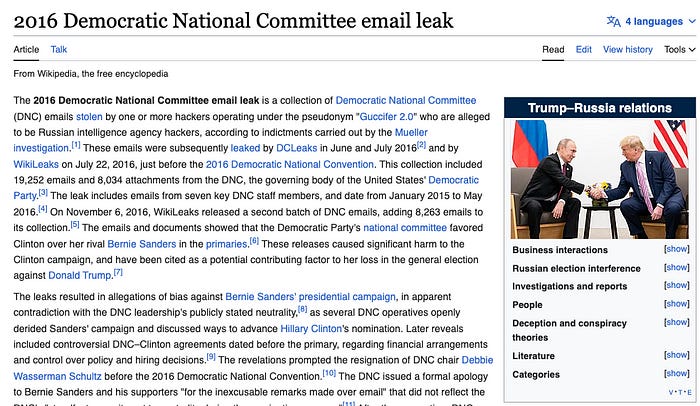
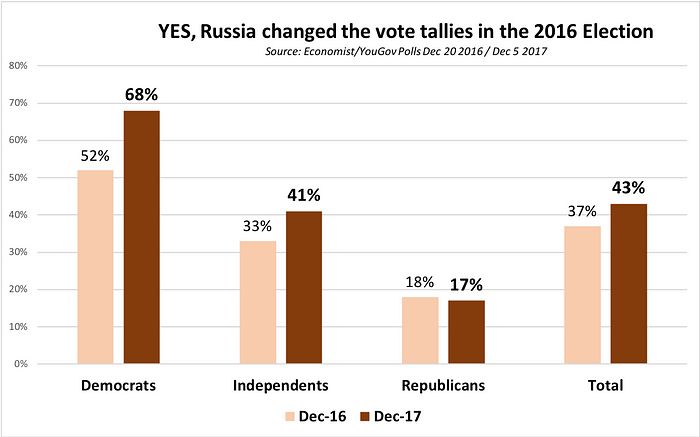




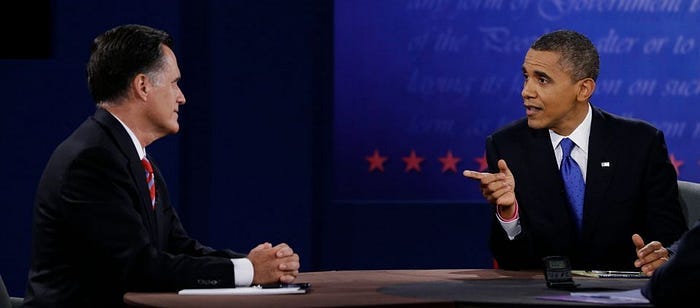


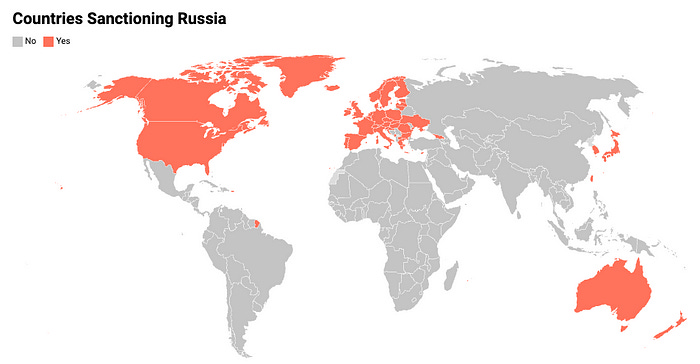




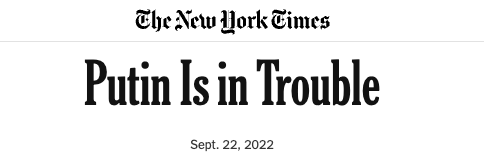

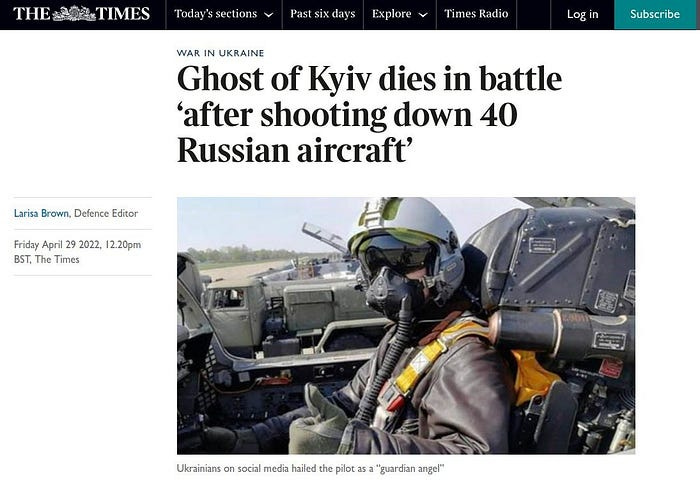
Fantastic article! Everyone should be sharing it widely.